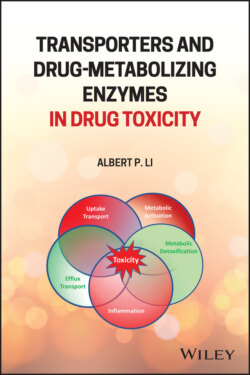Читать книгу Transporters and Drug-Metabolizing Enzymes in Drug Toxicity - Albert P. Li - Страница 34
2.5 Genetic Variants and Their Impact for Pharmacokinetic Behavior and Safety
ОглавлениеGenetic variation can result in decreased, unchanged, or increased enzymatic function [41, 42], and therefore could significantly impact drug safety by altering pharmacokinetic characteristics in certain individuals [43]. Based on decades of pharmacogenetic research, the association between genetic variation and drug metabolism has been established for many drugs [44]. The FDA has published a list of pharmacogenetic associations with sufficient scientific evidence [45]. However, often contradictory evidence for a given drug is reported, usually due to the limited statistical power in many studies. This is of particular importance in establishing associations between genotypes and DILI, as DILI has a very low incidence (~20 per 100 000 inhabitants annually) and clinical diagnosis is challenging [46]. The association between genotype and hepatotoxicity has been suggested for CYP2C9‐Bosentan, NAT2‐isoniazid and others (Table 2.2).
Table 2.2 Selected reports for the association between gene variations and drug‐induced liver injury.
| Gene | Variant | Function | Affected subgroups | Drug | DILI risk association | References |
|---|---|---|---|---|---|---|
| CYP2B6 | *1H and *1J (‐2320T>C) | Increased expression | Ultrarapid metabolizers | Ticlopidine | Increased risk | [47] |
| CYP2B6 | *6 | Decreased function | Poor metabolizers | Efavirenz | Increased risk | [48] |
| CYP2C9 | *2 | Decreased function | Poor metabolizers | Bosentan | Increased risk | [49, 50] |
| CYP2E1 | c1/c1 | Increased expression | Ultrarapid metabolizers | Isoniazid | Increased risk | [51] |
| NAT2 | *4 | Without active alleles | Slow acetylators | Isoniazid | Increased risk | [51–53] |
| UGT1A6 | A528G | Silent mutation | Tolcapone | Increased risk | [54] | |
| UGT2B7 | *2 | Decreased function | Poor metabolizers | Diclofenac | Increased risk | [55, 56] |
| GSTM1 and GSTT1 | Double null genotype | Decreased function | Poor metabolizers | Troglitazone | Increased risk | [57] |
| ABCB1 | 3435C>T | Decreased expression | Nevirapine | Decreased risk | [58, 59] | |
| ABCB11 | D676Y, G885R and V444A | Decreased function | Ethinylestradiol/gestodene | Increased risk | [60] | |
| ABCC2 | C‐24T | Decreased expression | Diclofenac | Increased risk | [55] | |
| ABCC2 | C‐24T | Decreased expression | Deferasirox | Increased risk | [61] |
For the major CYPs the single nucleotide polymorphism (SNP) has been estimated to be 14–127 per kilobase pair [62]. Of these SNPs, 9–41% are nonsynonymous variants. Only a limited number of SNPs (6–30%) have been cataloged or functionally annotated by the Pharmacogene Variation (PharmVar) Consortium, a public central repository for pharmacogene (PGx) variation (www.pharmvar.org). In addition to SNPs, variations such as insertions and deletions are present. The polymorphism phenotype can be categorized into four types; i.e. poor metabolizer, intermediate metabolizer, extensive metabolizer, and ultra rapid metabolizer. Poor metabolizer usually refers to individuals carrying homozygous or compound heterozygous null alleles (no function). In intermediate metabolizers one allele is partially defective while the other either is partially defective or null. For extensive metabolizers at least one allele is fully functional. Individuals with gain‐of‐function polymorphisms, e.g. carrying extra gene copies and mutations that enhance enzyme activity, belong to the ultra rapid metabolizer category.
